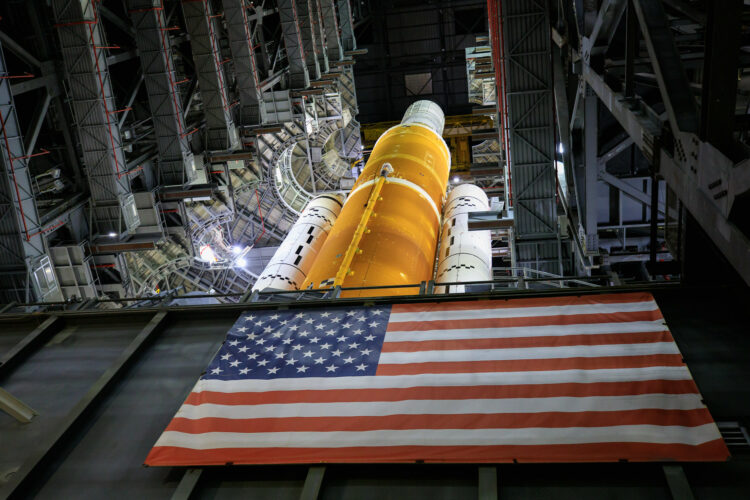The swing arms on the versatile dispatch tower for NASA’s Space Launch System delivered and withdrew Sunday night inside the Vehicle Assembly Building at Kennedy Space Center, one more key test on the walk toward takeoff of the Artemis 1 moon mission.
The Umbilical Release and Retract Test, or URRT, approved the manner in which associations between the Space Launch System and its versatile dispatch pinnacle will pivot or drop away at start and takeoff.
The swing arms and umbilicals give power, interchanges, coolant, and fuel to the Space Launch System and the Orion space apparatus on the platform, as per NASA.
The umbilicals segregated all the while from the almost completely collected Space Launch System moon rocket in the VAB high sound, similarly as they will during takeoff from cushion 39B at Kennedy to start the Artemis 1 mission.
Artemis 1 is the main experimental drill of NASA’s Artemis program, which intends to return space explorers to the moon during the 2020s. The main dry run of NASA’s new Space Launch System substantial lift rocket will send an unpiloted Orion group case into lunar circle for an exhibit mission enduring half a month. The Orion shuttle will get back to Earth for a splashdown and recuperation in the Pacific Ocean.
Future Artemis missions utilizing the SLS will dispatch four-man groups of space explorers to the moon on board Orion spaceships.
The Umbilical Release and Retract Test over the course of the end of the week confirmed past testing that elaborate separation of individual umbilicals from reproduced SLS interfaces.
“Past testing at the Launch Equipment Test Facility and in the VAB refined our plans and measures and approved the subsystems independently, and for Artemis 1, we needed to demonstrate our new frameworks would cooperate to help dispatch,” said Jerry Daun, arms and umbilical frameworks tasks supervisor at Jabobs, NASA’s ground frameworks worker for hire at Kennedy.
“This test is significant in light of the fact that whenever these ground umbilical frameworks are utilized will be the day of the Artemis 1 dispatch,” said Scott Cieslak, umbilical tasks and testing specialized lead, in a NASA articulation.
Not at all like the moving dispatch tables utilized by the space transport, the SLS portable launcher incorporates a monstrous high rise like construction on the actual stage. The 380-foot-tall (115-meter) Mobile Launcher includes a metal pinnacle on a two-story base with six swing arms that will withdraw away from the rocket before dispatch.
In the bus time, cushions 39A and 39B had fixed umbilical pinnacles to give space travelers, ground groups and swing arms admittance to the vehicle. The Apollo program’s Saturn 5 moon rocket utilized a comparative cushion arrangement as the SLS, yet the Saturn 5’s portable pinnacle had nine swing arms.
The SLS pinnacle and stage contain almost 1,000 bits of ground support hardware, steering power, information, water, fuels, cooling and different items to the dispatch vehicle and Orion team case.
During the withdraw test Sunday, six swing arms and umbilicals at the same time let out of the Space Launch System.
At the highest point of the rocket, the Orion Service Module Umbilical isolates from a mass test system stacked on top of the rocket to mirror the heaviness of the Orion space apparatus, which will be stacked later.
Underneath the Orion mass test system, the Interim Cryogenic Propulsion Stage Umbilical delivered and swung away from the rocket. Close to the highest point of the SLS first stage, the Core Stage Forward Skirt Umbilical and the Vehicle Stabilizer System arms disconnected as they will during dispatch.
The Core Stage Inter-Tank Umbilical, situated between the main stage’s fluid hydrogen and fluid oxygen tanks, and the Tail Service Mast Umbilical at the base off the rocket.
Other swing arms, for example, the Crew Access Arm to be utilized by space explorers boarding the Orion container, were not piece of the withdraw test. The group arm moves from the launcher in the last minutes of the commencement, not right now of takeoff.
“It was an extraordinary collaboration to construct, and presently test, these basic frameworks,” said Peter Chitko, arms and umbilicals joining chief. “This test denoted a significant achievement in light of the fact that every umbilical should set free from its association point at T-0 to guarantee the rocket and space apparatus can take off securely.”
Dissimilar to the moving dispatch tables utilized by the space transport, the SLS portable launcher incorporates a huge high rise like construction on the actual stage. The 380-foot-tall (115-meter) Mobile Launcher includes a metal pinnacle on a two-story base with six swing arms that will withdraw away from the rocket previously or during dispatch.
In the van period, cushions 39A and 39B had fixed umbilical pinnacles to give space explorers, ground teams and swing arms admittance to the vehicle. The Apollo program’s Saturn 5 moon rocket utilized a comparable cushion arrangement as the SLS, however the Saturn 5’s versatile pinnacle had nine swing arms.
The SLS pinnacle and stage contain almost 1,000 bits of ground support hardware, directing force, information, water, charges, cooling and different products to the dispatch vehicle and Orion group container.
The following achievement in Artemis 1 dispatch arrangements will be the Integrated Modal Test, as per Tiffany Fairley, a NASA representative.
Stingers, or shakers, will acquaint vibrations with the rocket as it remains on its help posts at the foundation of the versatile dispatch stage. Sensors across the rocket and along the portable dispatch tower, will gauge the thunderous reaction to the vibrations.
The rocket’s twin side-mounted strong filled sponsors each remain on four vehicle support posts, with the vehicle’s weight holding it on the versatile stage — without the help of hold-down bolts — during stacking, rollout, and the commencement before takeoff.
That will be trailed by expulsion of the Orion mass test system and the Orion Stage Adapter test article. Those will be supplanted by the flight-prepared stage connector and the genuine Orion rocket, which has been energized with in-space moving charge and mated with its dispatch cut short framework at Kennedy.
Professionals as of late finished establishment of ogive fairings over the highest point of the Orion rocket, giving the streamlined safeguard that will cover the case during dispatch.
After extra tests to check the mechanical and electrical associations between the Orion shuttle and the SLS rocket, NASA will be set the completely gathered launcher to cushion 39B on one of the organization’s Apollo-time crawler carriers.
The rocket will go through with regards to seven days on the cushion before NASA’s dispatch group goes through a reenacted commencement, finishing in the stacking of super-hold fluid hydrogen and fluid oxygen on board the dispatch vehicle.
Accepting that test, known as a wet dress practice, is a triumph, groups will deplete the charge, safe the rocket, and return the Space Launch System to the Vehicle Assembly Building for definite closeouts.
The time-touchy work inside the VAB after the wet dress practice will incorporate the establishment of pyrotechnic arms for the rocket’s division frameworks and reach wellbeing destruct system, which would end the flight if the rocket took off base after takeoff.
Then, at that point, the rocket will move back out to cushion 39B for one more seven day stretch of arrangements in front of the main dispatch endeavor.
Disclaimer: The views, suggestions, and opinions expressed here are the sole responsibility of the experts. No Unique Analyst journalist was involved in the writing and production of this article.

